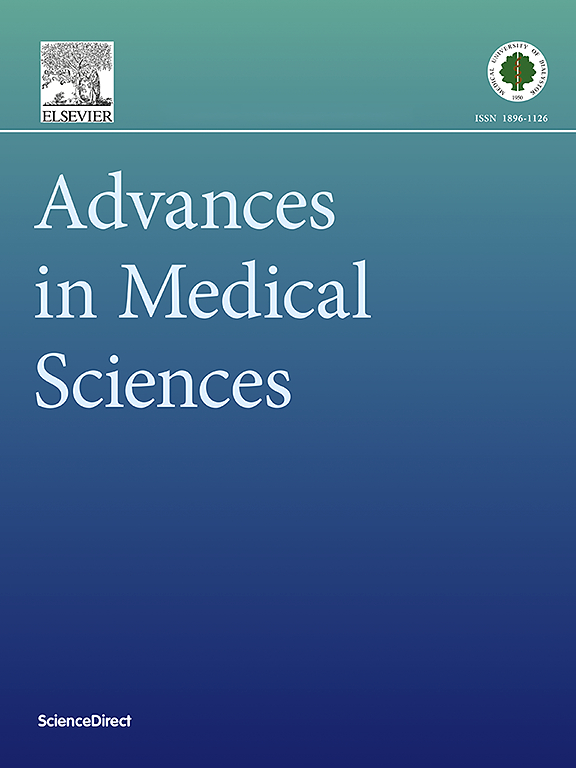Determinants and dynamics of the seroprevalence of anti-SARS-CoV-2 antibodies in Poland
IF 2.6
4区 医学
Q3 MEDICINE, RESEARCH & EXPERIMENTAL
引用次数: 0
Abstract
Purpose
In the present study, we aimed to assess the anti-SARS-CoV-2 antibodies in population and in convalescents 6 months after infection with COVID-19.
Patients and methods
The study population consisted of 2 groups, i.e. group I: 232 post-COVID-19 patients, and group II: 544 patients from a population cohort.
Detection of anti-N antibodies was performed with Elecsys Anti-SARS-CoV-2 and anti-S antibodies with LIAISON SARS-CoV-2 S1/S2 IgG tests.
Results
After the Omicron wave, gradual increase in the prevalence of the analyzed antibodies was observed in the general population - up to 92.5 % of anti-S and 69.7 % of anti-N antibodies. In the COVID-19 convalescents, 6 months after infection, 4.3 % and 3.7 % did not generate significant titers of anti-S and anti-N antibodies, respectively. Among patients, who were vaccinated, 1 % did not generate anti-S antibodies. The median age of non-responders was higher than that of responders. Sex did not influence the results. Comparison of anti-N and anti-S antibodies 6 months after infection in the whole group showed higher anti-N titer in patients who suffered from the disease than in the general population. In the general population, 17.4 % of participants had anti-N antibodies, and 9 % had anti-S antibodies, despite no prior vaccination or history of COVID-19.
Conclusions
High prevalence of anti-N antibodies in patients reporting no history of COVID-19 during last wave, even after official end of the pandemic suggests high prevalence of SARS-CoV-2 in the environment and frequent asymptomatic or unspecific COVID-19, what is of high importance from the public health perspective.
波兰抗sars - cov -2抗体血清流行率的决定因素和动态
目的:在本研究中,我们旨在评估COVID-19感染后6个月人群或恢复期人群的抗sars - cov -2抗体水平。患者和方法:研究人群包括2组,即I组:232例covid -19后患者,II组:544例来自人群队列的患者。采用Elecsys anti- cov -2检测抗n抗体,采用LIAISON SARS-CoV-2 S1/S2 IgG检测抗s抗体。结果:经过欧米克隆波后,所分析的抗体在一般人群中的患病率逐渐增加,抗s抗体和抗n抗体的患病率分别高达92.5%和69.7%。在COVID-19恢复期,感染后6个月,分别有4.3%和3.7%的患者抗s抗体和抗n抗体滴度不显著。在接种疫苗的患者中,1%没有产生抗s抗体。无应答者的年龄中位数高于应答者。性别对结果没有影响。全组感染6个月后抗n和抗s抗体比较显示,患病患者的抗n滴度高于一般人群。在一般人群中,17.4%的参与者有抗n抗体,9%的参与者有抗s抗体,尽管之前没有接种疫苗或COVID-19病史。结论:在上一波疫情中,即使在疫情正式结束后,无COVID-19病史的患者中抗n抗体的高流行率提示环境中SARS-CoV-2的高流行率和无症状或非特异性COVID-19的频繁发生,从公共卫生角度来看具有重要意义。
本文章由计算机程序翻译,如有差异,请以英文原文为准。
求助全文
约1分钟内获得全文
求助全文
来源期刊

Advances in medical sciences
医学-医学:研究与实验
CiteScore
5.00
自引率
0.00%
发文量
53
审稿时长
25 days
期刊介绍:
Advances in Medical Sciences is an international, peer-reviewed journal that welcomes original research articles and reviews on current advances in life sciences, preclinical and clinical medicine, and related disciplines.
The Journal’s primary aim is to make every effort to contribute to progress in medical sciences. The strive is to bridge laboratory and clinical settings with cutting edge research findings and new developments.
Advances in Medical Sciences publishes articles which bring novel insights into diagnostic and molecular imaging, offering essential prior knowledge for diagnosis and treatment indispensable in all areas of medical sciences. It also publishes articles on pathological sciences giving foundation knowledge on the overall study of human diseases. Through its publications Advances in Medical Sciences also stresses the importance of pharmaceutical sciences as a rapidly and ever expanding area of research on drug design, development, action and evaluation contributing significantly to a variety of scientific disciplines.
The journal welcomes submissions from the following disciplines:
General and internal medicine,
Cancer research,
Genetics,
Endocrinology,
Gastroenterology,
Cardiology and Cardiovascular Medicine,
Immunology and Allergy,
Pathology and Forensic Medicine,
Cell and molecular Biology,
Haematology,
Biochemistry,
Clinical and Experimental Pathology.
 求助内容:
求助内容: 应助结果提醒方式:
应助结果提醒方式:


